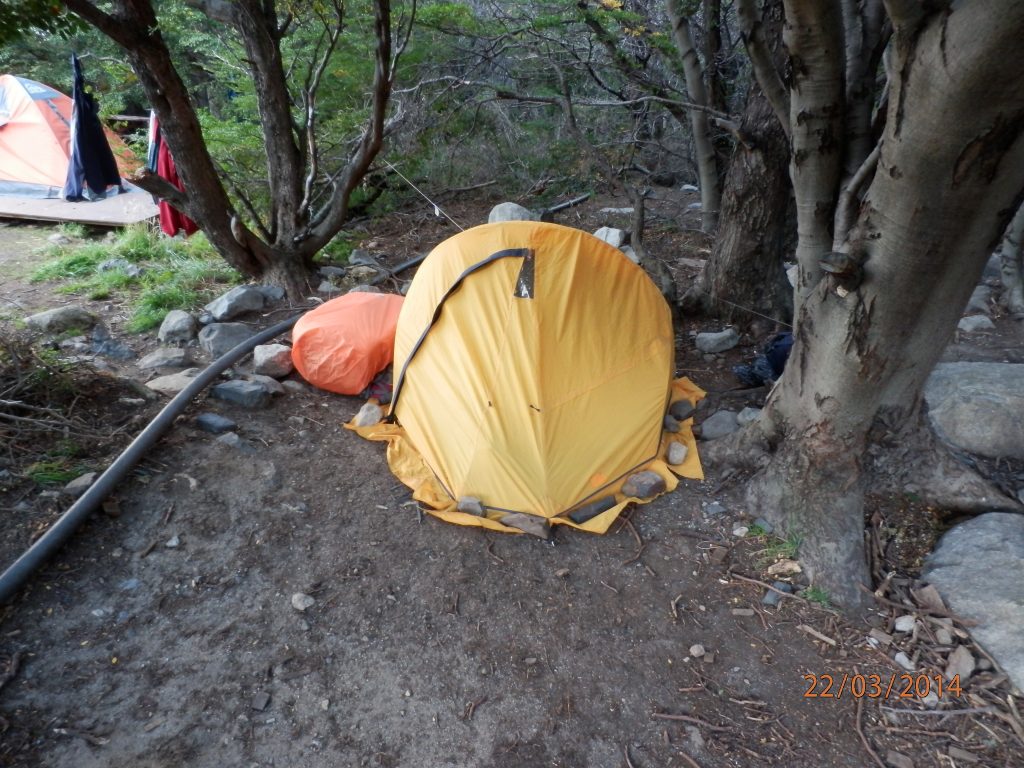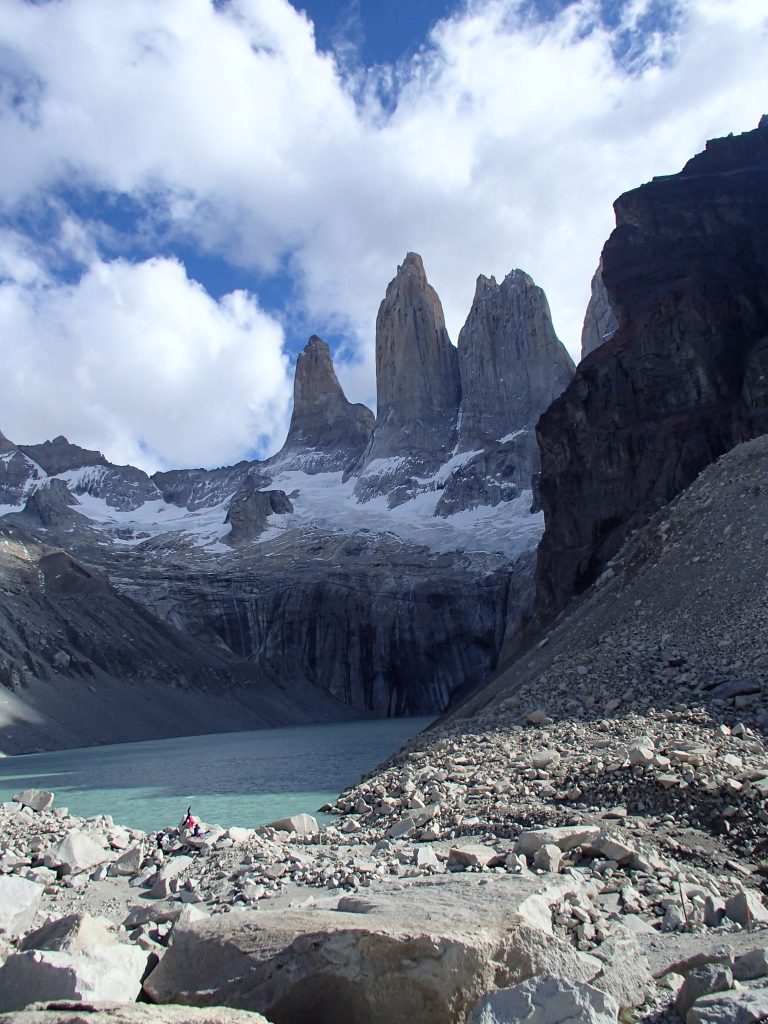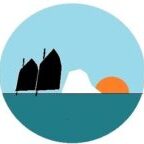IN PATAGONIA (WITH APOLOGIES TO BRUCE CHATWIN) (27 MARCH 2014)
Well, eventually the bus made it across the strait and we arrived in Punta Arenas. Six hours late – but this seems to be normal with that particular bus service. It was a good blooding into travelling in South America.
We spent a very restful couple of days in Punta Arenas, seeing what there was to see and enjoying the opportunity for almost unlimited sleep in our very comfortable hostel / B&B.
After 3 nights it was time to move on again, this time catching a bus to Puerto Natales, which is the jumping-off point for the national park at Torres del Paine, about 150km to the northwest. This was to be our destination ultimately, but first we would spend a couple of days in preparation. Puerto Natales is a very low-rise town, terminal port for the ferry service which runs through the Patagonian fjords to Puerto Montt, and Gore-Tex Mecca for those about to set off trekking in the Torres del Paine. It is a hodge-podge of mostly single-storey buildings of a remarkably temporary-looking nature: local building materials are timber, chipboard, tin (corrugated and uncorrugated), and that’s about it. However, the buildings seem to cope with the almost unceasing winds that blow hereabouts, whistling in the overhead wires, rattling the tin cladding and ruffling the mangy fur of the street dogs (which all seemed very keen on Stu- must remember to avoid his aftershave). The town centre has a more permanent feel to it, and is home to outdoor shops, hostels and handicraft shops, repeated with monotonous regularity. In amongst them are the usual selection of cafes, bars and restaurants catering for all tastes, as well as some fantastic general hardware stores, whose windows might display welding masks next to camping equipment, next to cooking pots, next to chainsaws.
One of the cafés, El Living, is where we found Sarah, a British lady with whom I had made contact through a rather tenuous family connection. The atmosphere here was so chilled and welcoming (and the food, albeit entirely veggie, so good), with a selection of reading matter in English, that we made it our base, second only to the hostel. Sarah was pleased to see us, help us to more scrummy cakes and excellent coffee and fruit juices, and chat when the demands of the other customers allowed!
One of the things we learnt through word of mouth was that there is a daily free briefing on trekking in the park at a hostel cum pub called Erratic Rock, so we made a point of attending this, and it provided us with some very worthwhile pointers for best completing the ‘W’ trek, which takes in the best of the sights. I would highly recommend this talk to anyone who is thinking of walking in the park.
The local eateries were good for meeting other potential Trekkers and other interesting folk- we fell in with some Americans who were very pleasant, and a Dutch couple, and sundry others. At El Living, Sarah also introduced us to a group of three British lads on their gap year travels, to whom Stu and I shamelessly peddled the idea of joining Nellie for one of her South American voyages. They, too, were introduced to Sarah via a tenuous (though less so than ours) family connection,and were due to go trekking at the same time as us.
The day arrived for our departure for the park, so we got the early bus, with dozens of others, and after signing into the park and paying our entry fees, we found ourselves on a catamaran service to take us to our starting point at Paine Grande Refugio, at the west end of the W. On the boat we met a couple from Oxford who were taking the luxury option of staying in refugios, and with whom we would meet up again later in the trek – by which time they would have got engaged!
The park is dotted with a number of privately owned Refugios (bunkhouses, in the more upmarket sense), where one can get a made-up bed, home comforts and three meals a day, but all for a price. Attached to the Refugios are campsites, which are considerably cheaper, and around the park are also a handful of government-owned, free campsites. Much as we would have liked to use the refugios, Stu and I had hired a tent to keep the cost down, so would be camping for the four nights we would spend in the park. The campsites of course attract people from all sorts of backgrounds – many Israeli students who all seem to be loud, rude and inconsiderate, and are widely considered to be the scourge of the park; there was a group of American students, also loud and brash but almost endearing in their naïvety and ignorance of the conventions of trekking and camping; there were also some very pleasant couples and pairs of friends with whom we could pass the evenings while cooking; lastly there was the occasional lone walker, keeping to themselves and walking alone (despite the park rules which stipulate otherwise).
We set off once we were ready on the first leg of the walk, up the valley to meet the shores of Lago Grey, and 11km almost as far as the three-pronged face of the Grey Glacier. The glacier is visible from several km down the valley, but our visibility was obscured on the first day by low cloud and rain / sleet / snow showers. It cleared as the afternoon wore on though, and by evening we were able to get a good view and some good shots from the viewpoint about 15 mins walk up the valley from the campsite. After a meal of pasta and some kind of artificial cheese sauce, we turned in for our first night under canvas. It is probably worth saying now that I hadn’t spent a night in a tent for about fifteen years, and therefore it took some getting used to. Stu was having similar problems getting comfortable, and we spent much of the night in our tiny 2-man tent dodging blows from each others’ knees and elbows. We did get some sleep, though, and awoke fresh-ish for the next day’s walking back down the valley and onwards.
The conditions were much better, and we got a much better view of the glacier most of the way down. We got to Paine Grande in time for a quick bite to eat, before continuing to Italiano campsite, at the foot of the Valle Frances (the middle prong of the W). This valley is supposed to offer fantastic views of hanging glaciers as you walk up and back, but only in good conditions. Unfortunately the forecast for day 3 was for pouring rain all day, so we were unlikely to get the views. As a result, we decided to skip this part, and carried on to the next campsite at Refugio de Los Cuernos. This was an extra 6 km tacked on the end of the day, making for a total of 24km walked, and this part of the walk was a tedious plod which both Stu and I had to grit our teeth for and push through the pain barrier to complete! We arrived at Cuernos with 30 mins to spare before the trail closed for the night, and set up our tent in a seemingly sheltered and level pitch in amongst some trees. It soon became evident that the sandflies also liked the shelter, and we were joined in the tent by several very quickly. As we cooked our meal that evening, the cookhouse (because of fire risk one is only allowed to cook in designated areas, most sites having a room or shelter designated for cooking on one’s own stoves) began shaking with the wind, which was beginning to pick up considerably. Once we had eaten, we retired to the tent and started to settle in for the night. As did the flies. And the wind. To make matters even more interesting the zip on the inner tent flap chose to give up under the strain of keeping our gear in the porch, so after much huffing and puffing we eventually had to secure it with safety pins from the first aid kit – not a very fly-proof solution. Once secured we immediately started sweating, as the wind, despite blowing now really quite hard, was very warm, so we adjusted the flap to allow a through-draught. Finally settled, we put our heads down, only for the real buffeting to start. The air outside was roaring through the surrounding trees, and every so often a violent gust would hit the tent. I had no fears of the tent coming apart, as it was actually pretty good and intelligently put together. However, each violent gust brought a blast of dust and grit through the ventilation meshes, so by morning we and everything inside the tent were encrusted. So filthy were we that we had to brave the two available showers with their idiosyncratic plumbing and complete lack of lighting.

Photo – Stu Sheldon
Thus cleansed, we packed up our gear and the soaking tent (as promised by the forecast, it was raining ropes, as the French would say) and left the campsite somewhat disgruntled.
The day’s walk took us to Torres Central, at the eastern end of the W, and actually wasn’t too bad, despite the rain. By the time we arrived, the rain had stopped and everything was looking much brighter. We pitched the tent and it dried. We cooked and ate and had a much better night’s sleep than the previous two.

Day 4 held the promise of an arduous, constant climb up the valley towards the base of the Torres themselves, where there is a free campsite. After the previous day’s rain, it was great to have some sunny weather in which we could walk unencumbered by our waterproofs. The walk was definitely tough with our heavy packs, but the views were fantastic, and we made it to the campsite after three and a half hours. We pitched the tent on a reasonably level pitch by the stream that runs through the wooded campsite, then headed up for the last 45 mins climb to the viewpoint over the Torres. The view is not disappointing, particularly on such a fine day, and the Torres particularly impressive, towering another 2000m above the tarn at the viewpoint. Up until the 30s nobody had seen round the north side of the three rock pinnacles. Now of course they have been climbed numerous times, and the more adventurous trekkers continue round the back along the Torres circuit track.
Back down to the tent, then we cooked our last pasta meal before retiring to a game of cards and bed.
It is said that the Torres are best viewed as the sun rises and hits their vertical rock faces. Stu decided he was going to put this to the test, so at 7 in the morning he was off again to slog up the 250m climb in the semi-darkness. I meanwhile had decided that once was enough, and awarded myself an extra hour in my sleeping bag for my good sense. The views were indeed good, apparently, and I enjoyed spreading myself out over both roll-mats for an hour and getting in a bonus dream.
Once we’d had breakfast and packed up, we headed off back down the same track as yesterday’s climb – this time downhill of course. We had a bus to catch at 1400, so didn’t hang around, and made it down in two hours, well ahead of the bus.
A minibus of dubious strength and quality took us down to the main bus pick-up point where we had paid our park fees five days before, and three hours later we were back in Puerto Natales, our hostel room floor covered in walking gear in various stages of soiling, and our appetites primed for an evening in the local brewpub for some real ale and a kilo of chips and chicken (and a salad for the scurvy).
We had one more day in town to return our rental gear and get our piles of laundry done, and now once again I am writing on the bus- this time back to Punta Arenas. Tomorrow we fly to Puerto Montt then hop on the night bus to Valparaiso.
